Carpenter Bee Control- The Onus is on You
To a naked eye, carpenter bees resemble bumble bees with yellow and black components. About one inch they possess metallic reflections that are available in various colours. In comparison to bumble bees their abdomens are shinier with a rich coating of hair. In the spring season they are a common sight in rails, porches etc. Carpenter bees are also known as wood bees as they love wood. It is not that they have a liking for wood due to nutrition. Though there are objects of wood boring, you cannot rate them to be a structural pest. It does not make an impact on the entire structure.
Steps for Carpenter Bee Control
Liquid treatments in the form of residual sprays
The carpenter bees are known to bore in the wood and it is recommended to spray the areas. The bees make their way into tarnished or polished wood. These holes set base on the underside of the wood including decks or window frames. It is recommended that you spray twice during the spring months at 3 to 4 months intervals.
In the event of severe infestations you would need to repeat the treatment more than twice. After each treatment close off the entry points. If it is kept away from environmental elements like rain it is going to last 3 months more. For efficient carpenter bee control it is suggested that the treatment should be applied in the late winter months.
Dust could be used as a form of Carpenter Bee Removal
If there is a current infestation, dust in carpenter holes with tempo dusts. Do spray dust and deep dust into the openings. It would be difficult to scrap up each individual gallery with insecticides but as all of us are aware current infestation is needed.
Plugging up the holes
The holes could be plugged by putty, cork or by caulking compound. Once all the bees are killed the holes should be plugged. To plug in the entrances the best time is the early months. If the entrances are plugged in too early, it is going to prevent the carpenter bees from passing through the insecticide dust whereby they make new openings in other locations.
To get rid of the carpenter bees is dependent on the particular time of the year as well. An early detection is going to prevent problems.
Bee traps
If you are advocating a non-chemical approach for carpenter bee removal, a trap would be a good idea. The traps are designed to attract and trap the bees. If there is already an infestation of carpenter bee, you can hang it over the carpenter bee holes. If there is no infestation you could hang it over the peaks or corners of your home. Ideally it should be undertaken from the portion of the room that is exposed to maximum rays of the sun.
Tips to keep current bee infestations away- Spray early and well into the early months of winter.
• For carpenter bee removal prevention is the key. Before you need to get rid of they prevent it.
• The exterior openings need to be sealed as much as possible. The carpenter bees are always on the lookout for cracks that protect entrances. These cracks should be sealed.
• Carpenter bees are known to attack sills and decks first. It is better to varnish or paint wood surfaces so that they do not become all that attractive. For a carpenter bee a fresh coat of paint will not be that attractive.
• From the previous seasons carpenter bees are known to reuse holes. Once the bees have emerged it would be better to caulk the holes.
• Any extermination or carpenter bee removal is undertaken well before the nesting season starts. If you do not have the time to paint or varnish unfurnished wood it would be better to catch hold of a good residual spray. As stated earlier the best time to apply spray is during the spring time. Rearing or nesting of carpenter bees does occur during the early summer or late spring. The impact of the spray is going to last for a couple of months

